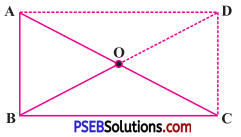Punjab State Board PSEB 8th Class Maths Book Solutions Chapter 3 Understanding Quadrilaterals Ex 3.4 Textbook Exercise Questions and Answers.
PSEB Solutions for Class 8 Maths Chapter 3 Understanding Quadrilaterals Ex 3.4
Question 1.
State whether True or False:
(a) All rectangles are squares.
(b) All rhombuses are parallelograms.
(c) All squares are rhombuses and also rectangles.
(d) All squares are not parallelograms.
(e) All kites are rhombuses.
(f) All rhombuses are kites.
(g) All parallelograms are trapeziums.
(h) All squares are trapeziums.
Solution :
(a) False
(b) True
(c) True
(d) False
(e) False
(f) False
(g) False
(h) False
Question 2.
Identify all the quadrilaterals that have:
(a) four sides of equal length
(b) four right angles
Solution:
(a) Squares as well as rhombuses have four sides of equal length.
(b) Squares as well as rectangles have four right angles.
![]()
Question 3.
Explain how a square is
(i) a quadrilateral
(ii) a parallelogram
(iii) a rhombus
(iv) a rectangle
Solution:
(i) A square is a four sided closed figure, so it is a quadrilateral.
(ii) The opposite sides of a square are equal and parallel, so it is a parallelogram.
(iii) All the sides of a square are equal, so it is a rhombus.
(iv) Each angle of a square is a right angle, so it is a rectangle.
Question 4.
Name the quadrilaterals whose diagonals:
(i) bisect each other
(ii) are perpendicular bisectors of each other
(iii) are equal
Solution:
(i) The diagonals of the following quadrilaterals bisect each other :
- Parallelogram
- Rectangle
- Square
- Rhombus
(ii) The diagonals of the following quadrilaterals are perpendicular bisectors of each other :
- Square
- Rhombus
(iii) The diagonals are equal in following quadrilaterals :
- Square
- Rectangle
Question 5.
Explain why a rectangle is a convex quadrilateral.
Solution:
- All the angles have measure less than 180°.
- Both diagonals lie wholly in the interior of the rectangle.
∴ The rectangle is a convex quadrilateral.
![]()
Question 6.
ABC is a right angled triangle and O is the midpoint of the side opposite to the right angle. Explain why O is equidistant from A, B and C. (The dotted lines are drawn additionally to help you).

Solution:
Produce \(\frac {1}{2}\) to D such that BO = OD.
Joining \(\frac {1}{2}\) and \(\frac {1}{2}\), we get a □ ABCD.
AO = OC (Given)
BO = OD (Constration)
∴ The diagonals AC and BD bisect each other.
∴ □ ABCD is a parallelogram.
∠B is a right angle. (Given)
∴ □ ABCD is a rectangle.
∴ BO = OD = AO = OC
∴ Point O is equidistant from points A, B and C.
